Holography Critiques
Illusions
Holography on Glass, 12"x18"; Circa 1990:
Carmenza Dominguez
Carmenza Dominguez
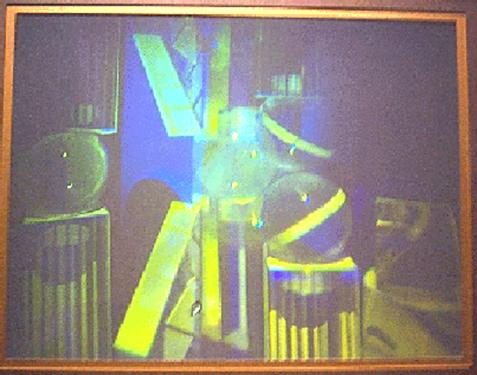
Carmenza Dominquez, a Colombian artist, produced this limited edition of 300 pieces. At first glance the piece appears to be a simple, abstract collection of glass objects stacked in a cluttered array. But further examination reveals this to be an extremely complex and profound work of art. This is not simply an accidental arrangement of glass nor a design that could have been thrown together without extensive thought, planning, knowledge of the tools of holography, and probably several attempts before making it all work. In this piece she throws out a challenge to other art forms by creating a scene that is impossible without holography. It cannot be replicated with painting, photography, or even sculpture.
If viewing original art is important with paintings, it is absolutely vital with some holograms, especially this one. The photograph provides a mere hint of what is included in the overall work, which does an excellent job of exploiting the medium of holography. This photo is merely a guide for the discussion of the holographic image, which must be seen to make the discussion finally meaningful. I will attempt with words to describe the trick that Dominguez has played on us, since it cannot be done with photography, painting or any other medium.
Pierre Boone Self Portrait
Hologram on Film; 12"x14" Circa 1998
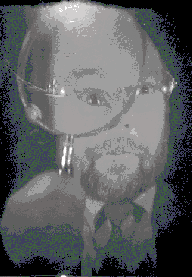 Portraiture and religion provided artists with patrons for centuries, serving as a primary use, and moneymaking role. Artists who could glorify the patron stayed fully booked. Photography usurped the bulk of this role of the painter by the end of the 19th century, though portraiture has continued as a major moneymaking endeavor for artists. Those who can afford a painting usually still choose that medium
in many cases because the artist can still provide a class not achievable by photography.
Portraiture and religion provided artists with patrons for centuries, serving as a primary use, and moneymaking role. Artists who could glorify the patron stayed fully booked. Photography usurped the bulk of this role of the painter by the end of the 19th century, though portraiture has continued as a major moneymaking endeavor for artists. Those who can afford a painting usually still choose that medium
in many cases because the artist can still provide a class not achievable by photography.
Holography is almost ideal for portraiture and yet its role continues to be evasive. Monochrome, holographic portraits are readily available at a price not much more than a photographic portrait from a high-end photographer and about the same as a painted portrait. Full color holographic portraiture is still not available to the general public. Portraiture is almost certain to become a primary use of holography and it is truly amazing that this has not already happened. Where else can one obtain an image as real as the actual person staring from behind a window?
Holographic self-portraits are more plentiful. The Figure illustrates an image from a self-portrait of Pierre Boone. Boone was one of the earliest scientists to recognize, develop, promote, and to use holography in art. He is a recognized contributor to the fundamental technology of art and display holography with many holographers using his bleaching formula referred to as “Boone's Pet”. In 2001 he was knighted by the International Order of Holoknights, an elite organization of leading holographers.
The white-light-reconstructed image is bright and clear with a wide viewing angle, excellent composition, color tuned to an amber-gray tint, demonstrating his great skill with holography. The work displays Boone’s fundamental knowledge of bleaching and use of film known only to a handful in the world. He exploits the dimensionality of holography further by holding a magnifying glass before him, which extends in front of the hologram plane. The viewer can choose to study his face through the glass or around it. Here Boone metaphorically challenges the viewer to examine him closely and judge whether he is a scientist, an artist, or both.
The magnifying glass in this self-portrait also symbolizes Boone's scrutiny of the art world as well as those who refuse to acknowledge his work as art. He has been verbal in his resentment that the art world seems to accept as art only work created by “artists”. He frequently publishes his own critiques of the art world and has published rules of art that include “A hologram by an artist is not necessarily art,”; He is quick to reprimand the often-used tact of artists who excuse poor holography technology as the artist’s prerogative.
Closer examination of the hologram reveals a burn spot to the left of Boone's face. This apparently occurred when the magnifying glass focused a part of the laser beam into a high concentration of light, showing that this commonly used “lens trick” in holography (to enhance the parallax) can be dangerous to the eyes in portraiture. Fortunately, the concentration of light missed his eyes, hopefully by design. Holographic portraiture is definitely not for amateurs.
Boone has been one of the most prolific holographic portrait artists in the world working in a university laboratory virtually next door to the Ghent Cathedral, in Belgium, which houses Van Eyck's famous Ghent Altarpiece. He has produced portraits of kings, queens, astronauts, AND……………this critic. His work includes other innovative ideas beyond portraiture as art. Having a Boone self-portrait in ones collection will some day be likened to having a self-portrait of Rembrandt.
The piece speaks with the vocabulary similar to that of pop art, but is really unlike any of the isms in art. The artist has divided the subject into two regions of blue and yellow. The soft blue soothing upper background and yellow lower background combine to form a green, which is not distinct in the photograph. Color saturation and brightness is another unique aspect of the hologram that can only be seen by observing the actual piece, and the bright pure colors seen in the actual hologram give the viewer a “feel” of a special aura and “softness” around the scene. A viewer will immediately sense that the source of the light is within the hologram itself, like colored candles buried within the hologram. Color in holograms requires special skill, which varies greatly between producers. The color in this piece is simple but works extremely well because of the subject matter.
The glass pieces appear transparent and nearly colorless. The sphere in the middle appears “smoky” giving it
Dominquez has chosen the fundamental sphere, cube, triangle and cylindrical shapes to give the viewer a sense of comfort and familiarity; without these the viewer would be lost. The cubes are produced from laminates, which give them more dimensionality and allow the viewer to seek different perspectives on the cube. In some angles, one can see through the cubes, while in others he cannot.
There is no left/right symmetry. For the most part, straight lines form the piece. However, adding curves to the pieces on the right breaks this rule. These curves illustrate the distorted views that occur from different perspectives. A number of triangles refer back to the symbolism of medieval art.
The hologram has been produced on Agfa Gavaert emulsion on glass, a material that is no longer commercially available. The technical quality is adequate but not superb. The hologram lacks in brightness, possessing a less-than-normal diffraction efficiency. The bleaching process used in this hologram appears to be from an earlier generation, possibly explaining the dimness of the image. The scene can be viewed over about a 30-degree angle so only two or three people can view it at one time, which is unfortunate since it is an excellent image to be discussed by several viewers.
A kind of symmetry about a horizontal line seems to exist. But a closer look reveals a troubling failure of the symmetry, a kind of anti symmetry, something like one might see in an Escher painting, images that cannot exist in a real world. Holograms can achieve in three dimensions what these “Escher” drawings only suggested. They can create images that sometimes are difficult to handle by our neural-visual system. The images in the upper half of the hologram are of this type. They are called pseudoscopic images of the items in the bottom half of the picture. The two images are called “conjugates” of each other. Sometimes one is called “real” and its conjugate is called “virtual”. The “real” image actually sits in front of the hologram. Pseudoscopic images are what the bottom objects would look like if one could go around and look at the front side while standing behind. Their perspective is reversed and they are “inside-out”, and the one is upside down relative to the other.
What the bottom figure tells us is closest to us, the top figure tells us is farther away and vice versa. So, when the brain attempts to interpret them, error signals appear, sometimes so severe that the brain refuses to interpret them. This can even have a “dizzying” effect on some people. Putting pseudoscopic images beside their real counterparts makes the effect even more confusing. Dominguez was kind enough to choose simple figures where the effect is more intriguing than overbearing to the viewer. Most artists discard the pseudoscopic image. Dominguez has used this aspect of the medium in a striking manner, making a powerful statement.
She has arranged these images so that some of the images and their conjugates overlap, producing a complementary effect. Others are separated. The psuedoscopic image typically is upside down, will appear separated from its conjugate unless it is centered in the field. She has placed all of the possible configurations here, with some overlapping, some in the hologram plane, some in front and some behind. Producing the hologram so that both images reconstruct in the same space like this is not something an amateur could do.
The piece speaks of communication, understanding, taking risks, and living life on the edge. She has placed two worlds, a “virtual” world and a “real” world side by side to coexist in the same space and they attempt to communicate in a middle ground. One can feel the excitement of venturing into the virtual space and trying to interpret it, always having the comfort of the real space nearby to rush back to for comfort. One could look at this piece for many hours without understanding the virtual world it contains and how it relates to the real world. The information is there but the communication and resolution of the two worlds must be left to the viewer. The viewer must bring some knowledge of pseudoscopic imagery to the piece to fully appreciate it.
Viewing this piece will have vastly different effects on different viewers. Many viewers will look at it without ever realizing a mystery exists. Others will realize that a mystery lies within, but will not be able to grasp what it is. Such a viewer can enjoy looking at it, simply because it makes him feel something he cannot understand. A viewer who brings some knowledge of pseudoscopic imagery with him to the piece can spend much time identifying the pieces in the puzzle and seeing which piece belongs to which.
PRIMAL WOMAN
Lucas, Circa 1985, 31/1000
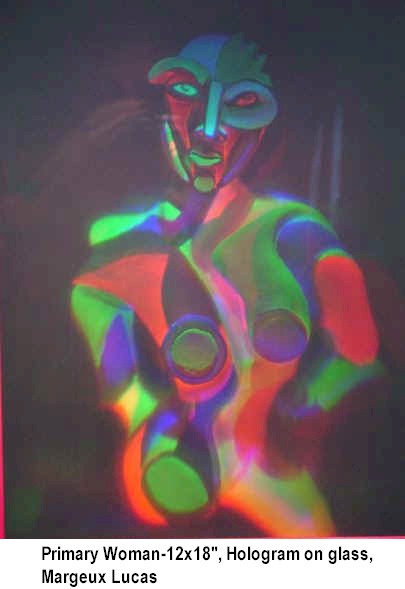 Primary Woman, by Lucas is part of a series, the first of which was Primary Man, a seminal piece, completed a year earlier. Perhaps this is fitting since the order is
biblically correct. The edition was limited to 1000 pieces. Unlike Primary Man which was face only, Lucas sculpted the entire body using some of the vocabulary of Picasso, without imitating him.
Primary Woman, by Lucas is part of a series, the first of which was Primary Man, a seminal piece, completed a year earlier. Perhaps this is fitting since the order is
biblically correct. The edition was limited to 1000 pieces. Unlike Primary Man which was face only, Lucas sculpted the entire body using some of the vocabulary of Picasso, without imitating him.
This work is a fundamental study in colors and mixing and how to use them in holography. Photographs or paintings cannot reproduce the colors that can be produced by the hologram. They are bright, luminous, and complementary chosen brilliantly by the artist to make a striking, almost living, but stylized woman. The plain black background emphasizes the richness and contrast of color and the full contour of the body. One can view this picture for a long time and continue to see more and more new detail from different vantage points.
By deliberately avoiding symmetry Lucas tells us much about her primary woman. Notice that the woman supports most of her weight on her right leg, hands on her hips, an artistic technique first employed by the Greeks in sculpture, known as contrapose. This provides her a classic confidence and determination in herself. Her left eye has a special ring around it denoting some kind of special power. This eye directly feeds the right brain, meaning that she has a special right brain perspective of the world that dominates her left-brain. The special significance for the right leg supports this theory.
Primary Woman's body has a split that runs from her crotch to her neck, a kind of super vagina, illustrating sexual prowess in an abstract way. Much abstract language adorns the figure, such as rings around the breasts, which can be interpreted as shackles that bind her to her role as a mother.
There are many advantages with the hologram over an actual sculpture, some practical and some artistic. The hologram can hang on a flat wall and create a useful space for the sculpture that does not exist in reality, depicting color that never existed on a real model. The original sculpture was always covered in portions of either black or white. The colors are selected by the artist from an imaginary, boundless palette. The original sculpture could be made of soft non-lasting materials, freeing the artist from working in stone or clay.
The series represents some of the earliest art holography that successfully employed a coloring procedure, developed in the early 80’s. Color in holography is still more of an art than science, with few artists having complete control. Holographic images of this type are formed by reflecting light from layers in the photographic emulsion. The color is determined by the separation of the layers. While a variety of methods have been developed to adjust that separation and thereby add color, this particular one employed an emulsion-swelling procedure that is by no means simple chemistry. The model is first covered in black with white added to a portion of it. An exposure is made then the emulsion is swollen by soaking it in a chemical solution. That sets a color for the portion of the model that is colored in white, while the black is not recorded. The white is changed to a new part of the model for subsequent exposures and new swelling amounts for different colors. In principle, many colors could be added sequentially, but two or three are the norm. Secondary colors emerge when two adjacent complementary colors are mixed, so we also see greens, orange and purples.
To the trained eye, Primary Woman can be as mysterious as The Gioconda and should be a lasting work taking an important place in art history.
I CAN FEEL MUSIC
Portrait of Saul Bryanston-Cross
Hologram on Agfa Glass Photographic Plate, 22X24
By Peter Bryanston-Cross
1993, No. 1 of 3.
Gallery of J. D. Trolinger
Provenance: From the artist in August, 2002
Produced at Richmond Holographics, London, UK
With assistance of Edwina Orr
Doubly-exposed, ruby laser, holographic interferogram
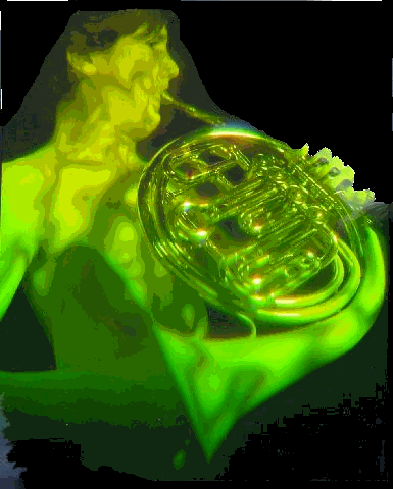 Saul Bryanston-Cross, 13 year-old (in 1993) son of the artist, is a natural and highly talented musician and composer, one of those rare individuals who can pick up an instrument, like this French Horn, and immediately produce pure notes, with no overtones. When asked how he knows that the note is in its pure form, his response is “I can feel it.”
Saul Bryanston-Cross, 13 year-old (in 1993) son of the artist, is a natural and highly talented musician and composer, one of those rare individuals who can pick up an instrument, like this French Horn, and immediately produce pure notes, with no overtones. When asked how he knows that the note is in its pure form, his response is “I can feel it.”
This piece is highly successful in exploiting the medium of holography to capture and convey to a sophisticated (trained) observer information, meaning, and emotion that cannot possibly be achieved with photography, painting, or even sculpture. As such it is a highly successful work of holographic art.
The photograph shown here is a mere representation of the actual piece, which must be viewed to study, enjoy and participate with its many features. The ability to capture and display parallax (providing different images and information when viewed from different angles) is a principle feature of holography. Viewer interaction is another. Parallax is, of course available in sculpture, but not in painting or photography (except for stereo photography, where it is still severely limited). The artist makes a very effective parallax-enhancing use of shadows in this composition, a technique known to and used often by seasoned art holographers. Shadows produced by the French horn on Saul’s body move in relation to the part of the horn that creates them when a viewer changes his head position, greatly enhancing and encouraging viewer participation with the piece. The bell of the horn protrudes over a foot in front of the hologram. The artist has chosen to place the face in the plane of the hologram, usually a wise choice in holographic portraiture because of limitations in lighting used during viewing.
The artist, Peter Bryanston-Cross, one of the most creative scientific holographers of the 20th Century, realizing that his son’s “feeling"” might be made observable through the application of holographic interferometry, produced this holographic portrait that displays visually and quantifies, to the trained eye, the feeling process described by Saul.
The fringes in the horn show how the sound vibrations move the horn, displaying visually what we would have heard if we had been there during the recording. Even an untrained observer can connect the patterns to sound without much imagination. We are effectively seeing the movement that is causing the sound coming from the horn, the same sound that can be heard by the musician, and also the sound trapped in his bones and felt by his body.
Recording two superimposed, minutely different images of an object with holography enables the display of the separation of the two object positions. Such recordings exhibit contour fringes that can detect and display minute movement a subject caused by sound vibrations.
From the scientist’s view, a strong resonance can be observed through the fringes in Saul’s collarbone, facial structure, and chest wall. His bone structure, acting like large sound antennae, conveys information to his brain that his ears cannot. The resonances would be felt strongly by him when certain resonant frequencies are achieved, and he would be able to detect easily any overtones present in his bones if he “listens” with his body. Ears are designed to listen in a completely different way and could not provide the same type of information.
This unique piece displays a strong interaction of science, music, and art, employing vocabulary from each. We can share sound and feeling of the music without a sound from the picture. The hologram literally sings to us through fringes. In addition to a strong technical message, the piece offers a strong artistic, moral message.
”I Can Feel the Music” is about communication between a boy and his father and the effort and training required by both to communicate in a meaningful way. What the son feels can go completely unknown to a father who is not willing to go the extra mile. If the father listens, believes, asks questions, and strives to understand, then the rewards are great. Here the father demonstrates to his son that he can hear him in ways that he may not understand, since understanding may require him to use language and knowledge of his own that may be completely foreign to the son. This work of art is a testament to the richness of information that can be conveyed between any two individuals whose goal is communication and whose strategy involves trust and employs whatever tools and language they command.
The piece also implores us to listen to our own bodies.
The technical quality of the hologram is excellent, exhibiting a bright low noise image of high resolution. Much of this can be attributed to the production of the piece in Richmond Holographic Laboratories, where the latest in recording technology and chemistry were available. Only in such a highly advanced laboratory could a hologram of this quality be produced. This work of art is also a testament to teamwork, pushing the limits in pulsed laser holography and processing chemistry. In the actual piece an observer can count the hairs on the musician’s head, can focus and examine in microscopic detail over a depth of over two feet, much more than can be achieved in this simple photograph, which is only representative of a single viewing angle and depth. The image is viewable over a wide angle, allowing several viewers to examine and discuss the piece simultaneously.
Holographic artists have a fairly wide range of color choices in a monocolor piece of this type through processing techniques. Artistically, it is extremely important to choose a color that is harmonious with all of the key items in the work. Here, the color choice has not only matched the gold of the French horn, but somehow gives the impression of a pleasing skin color. One of the major problems in this type of portraiture is finding a skin color that compliments the person, since full-color holographic portraiture is still rare even today. Available colors usually do not compliment the person. Providing an acceptable skin color seems easiest with a black model; however, placing the French horn in the scene with a young boy, leaves the viewer with a perception that the skin color is complementary and even flattering. This hologram introduces a green tint in the lower left hand corner of the hologram that seems to move the skin color in the correct direction, while giving the highlights on the horn a definite gold appearance. Even Joseph Albers would have been impressed with this artist for achieving this pleasing effect.
Brief Summary
"I Can Feel the Music" is an exceptionally strong art work because it is so rich in almost every aspect of art holography. It will be recognized in the future as a rare masterpiece and a unique example of holographic art for numerous reasons. Here are some of those reasons. It contains an aesthetic subject with deep meaning about a relationship between a father and son presented in an unusual manner. It contains deeper meaning about society in general. It exploits the medium of holography to produce effects that could be obtained in no other fashion. It is of a rare genre that combines advanced scientific knowledge with artistic creativity using complex vocabulary of both. It is of high technical quality. Only three copies exist, and since it is produced on a material that has not been available since the late nineties, no more copies will be produced. It cannot be counterfeited. It is unusually large for holographic portraiture. It is associated with a unique production team that included a highly reputable holographic laboratory and a scientist/artist who is well known and widely published. The team spent many hours conceiving, composing, and producing this hologram. It is interesting and easy to view, to participate with, to analyze, and to discuss.
"I Can Feel the Music" was exhibited in the Bremen Focke Museum in 2001.
Interestingly enough, an art professor, upon studying this piece for a while commented that this was only a three dimensional image and could not be considered art. It is truly amazing how little someone sees when he refuses to look.
At some time in the not too distant future "I Can Feel the Music" will be a highly prized piece in the permanent collection of a public gallery. The remaining copies are in possession of the artist.
Lucy in a Tin Hat Critique
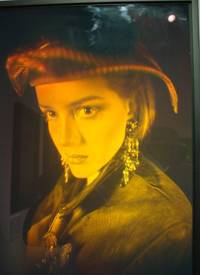
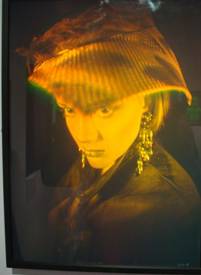
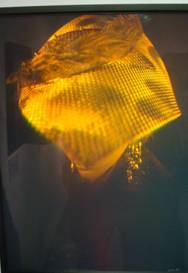
Lucy in a Tin Hat-Hologram by Patrick Boyd
Lucy in a Tin Hat by artist Patrick Boyd is what I would call the “Mona Lisa” of holographic art. This piece sets the bar in holographic representational art, and serves as an excellent example of what a skilled holographic artist can achieve with the medium. While many excellent holographic portraits exist, Lucy is much more than simply a holographic portrait; she is a holographic art masterpiece. The three figures here, taken from the hologram, are meant only for guidance and in no way simulate the experience of viewing the hologram.
Boyd exploits at least three features of great holographic art, 1) an excellent technical quality, 2) excellent artistic strategy and esthetics, and 3) outstanding exploitation of the holographic medium to achieve what cannot be achieved by other art
From a technical point of view Lucy demonstrates a quality that is rarely seen in holograms, since holographic artists often offer “artistic license” as an excuse for poor technical quality. It has a very wide range of viewing, large depth of field, high resolution, bright, clear image and a large dynamic range with no visual defects. The piece was produced by projecting the three dimensional image from a master hologram into a new recording, one of the many ways to produce art holograms.
Boyd exploits conventional art strategies often employed in great portraiture, capturing an extremely intense expression of an elegant woman. Her eyes are the focal point of the piece, positioned strategically in the golden section* with a golden face surrounding the golden section and a classical three quarter view (at first glance). The black background and a black leather jacket eliminate all distraction and enable the widest range of both value and contrast, far greater than you can ever see in a photograph or painting.
As in all great art, compositional tricks lead the viewer’s eye to explore the entire frame. Lucy’s hand leads the viewer’s eye to move back along the highlighted jacket collar, around her gleaming hair, and along the hat brim in a full rhythmic circle about her face and jewelry. This would be a great portrait even if it were two dimensional, but we have just begun to look, and we are already intrigued and may not even consciously know why.
Boyd’s composition exploits features unique to holography. The strategically placed, long, ear rings play an important role in enhancing parallax, a feature that is lost in photography. On first viewing, my left eye can see clearly the left ear ring which is hidden to the right eye by parallax, a clear signal to my brain that this is a three dimensional Lucy, even before I move my head. The guiding lines in the piece cause my eyes to move around the frame further enhancing this effect. This invites me to move sideways until the ear ring comes in view to both my eyes and allowing me to view both sides of Lucy’s face. Boyd has placed her eyes in the plane of the hologram, where they will be in sharper focus than any other plane (a characteristic of this type of holography).
Upon first viewing, Lucy gazes off to the side of the frame, but I am led to move until I can look straight into her eyes, giving me almost a full range from head on to profile. In a photograph or painting eyes will follow you. Not so in holography, where from an optical of interpretation, this is the equivalent of having the real Lucy trapped and frozen behind a window. I can choose either to observe her or communicate directly with her. Through holography Boyd allows me to interact with Lucy.
Vertical parallax, available in this type of holography, is usually wasted since our two eyes are horizontal-not so in this piece. But here a well designed hat protrudes far in front of Lucy’s face. Consequently, as I raise my point of view the hat blocks my view of her face telling me that I am now rising above her. Indeed, I see the top of her hat that blocks her face. Boyd has made the perfect choice in monochrome. The black, which is not really a color, combined with gold appears as a second color, and provides the widest possible range of values and contrasts. This gives us the impression of seeing more color than really exists in the image.
An art piece such as Lucy does not happen by accident; it takes knowledge, talent, design, planning, creativity, good equipment, probably a lot of failed attempts and also luck. This piece is successful not simply because it is a good hologram; it is successful because Boyd has integrated and successfully exploited the medium of holography with good art practise. Hologram copies of this piece can be purchased for about 2000 pounds.
*Note: The golden section is a well known “sweet spot” in art located approximately one third from two sides of the frame, so that the ratio of distances to the sides is the so called “divine ratio”.

